2. 中核北方铀业有限公司, 葫芦岛 125000;
3. 深海圈层与地球系统前沿科学中心, 海底科学与探测技术教育部重点实验室, 中国海洋大学海洋高等研究院和海洋地球科学学院, 青岛 266100;
4. 青岛海洋科学与技术国家实验室, 海洋矿产资源评价与探测技术功能实验室, 青岛 266100
2. North Uranium Co., Ltd CNNC, Huludao 125000, China;
3. Frontiers Science Center for Deep Ocean Multispheres and Earth System, MOE Key Lab of Submarine Geosciences and Prospecting Techniques, College of Marine Geosciences, Ocean University of China, Qingdao 266100, China;
4. Laboratory for Marine Mineral Resources, Qingdao National Laboratory for Marine Science and Technology, Qingdao 266100, China
韧性剪切带是岩石在塑性状态下发生连续变形的狭窄高剪切线状应变带,是地壳中深层次的主要构造类型。韧性剪切变形作用控制和影响地壳的形成和演化,是研究地壳深部构造变形机制及变形环境的重要对象,受到了国内外学者的普遍关注(郑亚东和常志忠,1985;许志琴和崔军文,1996;蔡学林等,2008;Montési,2013)。20世纪70年代,Ramsay and Graham(1970)分析了韧性剪切带的形成机制,随后开始了包括几何学、动力学等方面的研究;Sibson(1977)和Ramsay(1980)发表了韧性剪切带的经典论著,为之后的研究奠定了基础。20世纪80年代,研究重点转为剪切带内部变形机制的研究,如对韧性剪切带的塑性变形及旋转应变特征(许志琴, 1984a, b;何永年等,1988)、在不同条件下形成糜棱岩的显微和宏观构造特征(孙岩等,1986)、韧性剪切带形成过程中细颗粒物质沿剪切面方向形成的显微分层现象(刘瑞珣,1988)等方面进行了系统的研究。20世纪90年代,对韧性剪切带的研究更为深入和成熟,包括对韧性剪切和脆-韧性转换变形过程中岩石变形的问题(林传勇等,1992)、韧性剪切带内岩石化学组分变化和蚀变岩分带以及剪切带构造岩分带(韦星林,1996)、韧性剪切带内宏观构造特征和显微构造特征的描述(万昌林,1997;舒良树等,1998)、糜棱岩矿物组构以及形成机制(顾德林等,1998)等的研究。21世纪以来,随着研究手段的增多,特别是磁组构测量、X岩组分析、EBSD测量以及三维应变分析等新方法的应用,人们对韧性剪切带的研究也从传统的野外构造变形观测为主过渡到更加侧重室内显微构造的分析,经历了从定性到定量研究的发展过程(肖勇,2001;李晓峰等,2007;王春增等,2009;张雪峰,2015;董浩强,2018)。
韧性剪切变形作用作为一种重要的构造运动形式,对于矿床形成及演化具有十分重要的影响。韧性剪切带型金矿是一种重要的金矿类型,其与韧性剪切带的形成和演化密切相关(Boyle,1979;Bonnemaison and Marcoux, 1990;段嘉瑞等, 1992;刘继顺,1996;董浩强,2018)。韧性剪切变形作用不仅有利于成矿元素的迁移富集,还为金矿的富集沉淀提供了容矿空间(陈柏林等,1999;杨晓勇,2005;Kolb,2008;Zeng et al., 2014, 2020;杨鑫朋等,2015)。30余年来,韧性剪切带型金矿研究取得了重大进展,Roberts(1987)根据里德尔剪破裂理论创立了包括R型、R′型、T型、D型和P型五种类型的韧性剪切带含矿裂隙系统;Sibson et al.(1988)和Boullier and Robert(1992)共同建立了断层阀模式,即金矿形成于脆-韧性转换带位置,流体从韧性带到脆性带时,压力的突然降低使矿物沉淀成矿。Bonnemaison and Marcoux(1990)提出了剪切带金矿化的三阶段成矿理论,包括早期含金硫化物形成阶段,中期金呈矿物形式出现阶段以及晚期块金形成阶段;陈柏林等(1999, 2002)认为剪切带型金矿床具有成矿作用晚于韧性剪切带形成时代、空间分布规模各异、成矿物质来源难以区别、韧性变形强度越强金元素含量越少等特征。汪劲草等(2020)认为构造作用与成矿作用具有阶段性与脉动性,其演化具有递进性与不可逆性,提出韧性剪切带型金矿三阶段构造-成矿演化模式。
韧性剪切作用与铀矿化关系也十分紧密。在造山带构造体制转换环境下,铀元素的活化、迁移和沉淀过程与脆-韧性剪切带紧密相关(韦昌山和翟裕生,1996; Yan et al., 2003a, b; Qiu et al., 2018)。在空间关系上,如纳米比亚斯瓦科普蒙德地区含铀花岗岩体受NE向韧性剪切带控制(聂江涛等,2013),铀矿体受与韧性剪切带有关的混合岩控制(尹明辉等,2019)。在成因方面,多位学者探讨了剪切应变背景下岩石组分活化、转移与应力、应变的成因联系,并建立了铀成矿模式(孙岩等,2001;杨晓勇,2005;王正其等,2010;李建波等,2012;梁良等,2019;陈峰等,2019)。
辽吉古元古活动带位于华北克拉通东北部, 带内矿产资源丰富, 目前发现有铀、金、银、铁、铜、铅、锌、钴等金属矿以及硼矿、菱镁矿、岫玉和滑石矿等非金属矿产, 区域成矿作用可能与裂谷演化关系密切(陈荣度, 1984, 1990; 李三忠等, 1996, 1998, 2001; 翟安民等, 2005; 宋建潮, 2011; 周永恒等, 2011; 董存杰, 2012; 张朋等, 2016)。值得关注的是, 辽东地区是中国最古老铀矿床(点)集中分布区和很好的潜在铀成矿省(夏毓亮和韩军, 2008)。目前在辽东发现的铀矿床主要产于连山关地区, 对于该区铀矿床成因, 不同学者持有不同的观点,包括:沉积变质-热液改造型(郭智添, 1982, 1986; 钟家蓉, 1983; 刘德正, 1990)、碱交代热液脉型(王驹和杜乐天, 1988; 刘正义等, 2019)、热液脉状充填型(张家富, 1990; 张家富和徐国庆, 1994)、混合岩化热液脉型(连立祥, 1989; 杨福鹏, 2010; 佟国元等, 2012)、不整合脉型(董春林和薛树桐, 1992; 张振强和曲先良, 2001)、重熔混合热液型(庄廷新, 2009①; 吴迪等, 2013, 2017)和构造热液型(张小勇等, 2015; 郭春影等, 2018)等观点。
① 庄廷新. 2009.连山关地区前寒武纪构造演化特征及与铀矿化的关系.沈阳:核工业240研究所
近几年,随着连山关地区铀矿勘查进展,发现已知铀矿床(点)均分布在连山关花岗杂岩体与辽河群接触带附近,受韧性剪切带控制,前人对连山关地区铀矿成因、年代学、地球化学都做了大量的研究工作,但构造控矿规律仍不清楚,特别是剪切带控矿缺少深入、细致的研究工作,导致对区域成矿规律的认识不深入。鉴于此,本文以连山关岩体周缘韧性剪切带为研究对象,探讨其运动学、几何学构造变形机制及与铀成矿的关系,进而填补前人研究的薄弱环节,以期完善本区铀成矿模式,对今后该区铀矿找矿工作提出新的思路。
1 地质背景华北克拉通作为地球上最古老的克拉通之一,拥有38亿年的演化历史,与其它克拉通相比,其构造演化更加复杂,几乎记录了地球早期演化过程中所有的重大构造事件,包括陆壳形成与增生、板块构造初始活动、超大陆聚合与裂解以及全球大氧化事件(Liu et al., 1992, 2008, 2017;Song et al., 1996;翟明国, 2010, 2011, 2019)。胶-辽-吉活动带位于华北克拉通东北部,目前对其大地构造属性还存在着诸多争议(张秋生和杨振升,1988;李三忠等, 1997;郝德峰等, 2004;Li et al., 2006; Li and Zhao, 2007;Luo et al., 2008;秦亚等,2014;刘福来等,2015;陈斌等,2016; Liu et al., 2018, 2020;沈保丰等,2020)。张秋生(1987)将胶-辽-吉活动带划分为“两块一带”,即北部龙岗地块、南部的狼林地块和两者之间的辽吉古元古裂谷带(图 1a)。
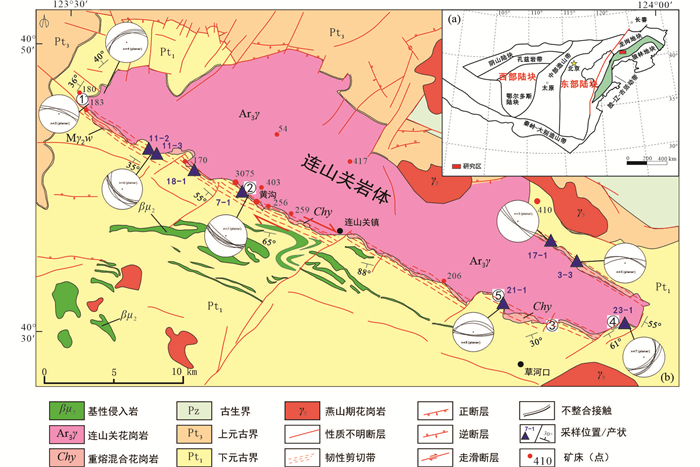
|
图 1 研究区地质简图 (a)华北克拉通构造单元划分(据Zhao et al., 2005);(b)连山关地区地质简图.图内赤平投影为韧性剪切带内片理或片麻岩的产状.图中序号①~⑤代表观察点位,详细描述见后文 Fig. 1 Geological map of the study area (a) division of tectonic units in North China Craton (after Zhao et al., 2005); (b) regional of geological map of the Lianshanguan area in East Liaoning. The stereographic projection shows the occurrence of schistosity or gneiss in the ductile shear zone. Numbers ①~⑤ in the figure represent the observation points, detail description are given below |
研究区位于辽吉古元古代裂谷带北缘,主体构造格架为一轴向北西西向的短轴背斜,核部为太古宙混合花岗杂岩体,翼部为古元古界辽河群沉积变质岩系所覆(图 1b)。区内主要出露太古宙结晶基底、太古宇鞍山群和古元古界辽河群沉积变质岩系,同时伴有少量的古元古代基性岩墙群。其中,鞍山群呈残留体赋存于混合花岗杂岩体中,区内仅有茨沟组及大峪沟组分布;辽河群在区内分布广泛、出露完整、韵律明显,构成一巨大沉积旋回,共出露5个岩组,从下往上依次为:浪子山组,为碎屑岩-黏土质岩建造;里尔峪组,为酸性岩-火山岩建造;高家峪组,为黏土质-半黏土质建造及碳酸盐建造;大石桥组,为碳酸盐建造;盖县组,为碎屑岩建造。
研究区构造发育,包括脆性断裂和韧性剪切带,前者主要有NW向、近EW向断裂组与NE向、NNE向断裂组,发育在辽河群及岩体接触带附近;后者主要发育在连山关岩体南带与辽河群不整合面,呈现糜棱岩、片理化带。研究区侵入岩主要包括太古宙和古元古代两个演化时期。太古宙岩体以连山关混合花岗杂岩体为代表,该混合花岗杂岩体西起弓长岭、东至草河城,呈近东西向分布,岩体长40km,宽7~10km,面积约320km2,构成连山关复背斜的轴部;杂岩体主体由红色钾质混合花岗岩组成,其间有少量早期钠质花岗片麻岩残留体,并大量分布太古宙鞍山群残留体,边部分布白色重熔混合岩(吴迪等, 2013, 2017);背斜核部连山关岩体平均含铀量为6×10-6~8×10-6,是辽东地区主要铀矿远景区之一(郭智添,1982;庄廷新,2009;吴迪等,2013)。古元古代侵入体主要为基性岩,走向与韧性剪切带一致,呈北西向展布于辽河群中,岩性多为辉长岩、辉绿岩,以层状或脉状形态产出,经历了区域变质作用(卢天骄,2019;刘杰勋,2019;许王,2019;薛吉祥等,2020)。
2 韧性剪切带变形特征 2.1 宏观变形特征 2.1.1 连山关花岗岩体构造变形特征连山关岩体周缘均发育不同程度的韧性剪切带,岩体南缘和东北缘剪切变形发育,东、西两端构造变形相对较弱,北侧被新元古界地层覆盖(图 1)。岩体南缘韧性剪切带呈NWW向展布,长37km、宽1.5km,总体表现为强弱不同的变形特征,既发育挤压褶皱又发育右行走滑剪切变形,从西到东与辽河群浪子山组地层的接触关系均为构造接触,原始的沉积不整合接触关系几乎被改造消失,取而代之的是强烈的韧性剪切变形带(常瑞虹等,2017),仅在岩体的西缘变形较弱的区域内,还能见有代表不整合关系的底砾岩存在。关于韧性剪切带的变形特点详细描述如下。
岩体西缘连山关岩体和上部辽河群之间变形非常弱,保留有很好的原生构造,在三道岭(图 1b①处)见连山关岩体与上覆浪子山组底部石英砂岩之间的沉积不整合接触关系。从下向上依次出现新太古代花岗岩,其中发育有一些小型石英脉,这些脉体被不整合面截断;向上出现砾岩,砾石为花岗质;再向上出现石英岩,其中含有很多大块花岗岩砾石,呈棱角状(图 2a)。这一完整的接触关系保留完好,没有遭受后期的构造改造,说明下伏连山关花岗岩为辽河群的沉积基底。
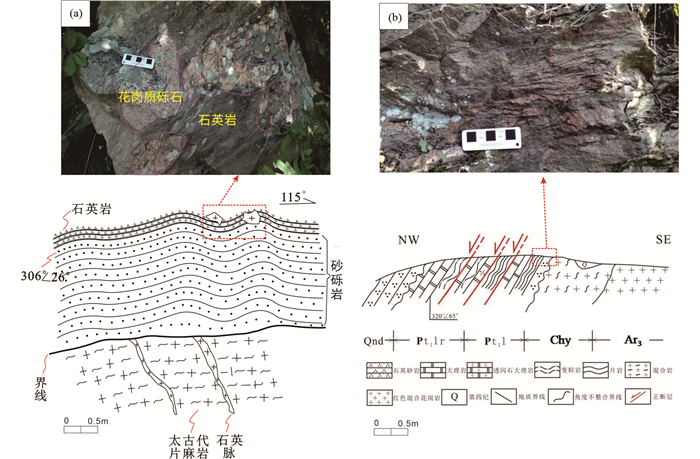
|
图 2 连山关岩体西缘不整合接触关系及构造剖面图 位置见图 1b①处.(a)辽河群底部花岗质底砾岩;(b)韧性剪切带内形成的透镜体 Fig. 2 Structural profile and unconformity contact relationship in western margin of the Lianshanguan granitic pluton Location is shown in Fig. 1b①. (a) granitic basal conglomerate at the bottom of Liaohe Group; (b) lens formed in ductile shear zone |
后期的构造变形主要发育在不整合面之上的浪子山组片岩中,这主要是因为接触带以花岗质砂砾岩为主,能干性强,在后期变形中不容易发生滑动;而上面的片岩比较软,能干性弱,易于发生构造变形。在浪子山片岩中发育有顺层剪切变形,剪切面倾角一般为45°~55°之间,根据挤压透镜体和眼球构造的排列形式,可以确定其剪切滑动方向指向北西(图 2b),整体反映连山关岩体隆升,上覆浪子山组地层向北西一侧滑脱的变形特征。
岩体南缘构造变形比较强烈,既有挤压褶皱又发育右行走滑剪切变形。岩体南缘从西到东与辽河群浪子山组地层的接触关系都为构造接触,原始的沉积不整合接触关系已经被改造消失,取而代之的是强烈的韧性剪切变形带。从接触带产状上看韧性剪切带的西段产状相对较缓,为200°~225°∠35°~55°;中段产状变陡,为162°~190°∠65°~88°;东段产状又相对变缓,约为150°~158°∠30°~50°(图 1b),这说明岩体南缘东西两端和中部相比变形相对较弱,反映南缘中部遭受的来自南部的挤压应力相对较强,使接触带和上覆辽河群地层都发生褶皱变形,南缘中部(图 1b②处)产状近直立,同时伴有强烈的右行走滑剪切变形(图 3a, b)。在南缘东段(图 1b③处)接触带产状很缓,倾角一般在30°~35°之间。发育顺层滑动剪切变形,滑动方向为SE,反映花岗岩体相对隆起,上覆辽河群地层向外侧滑动剪切的变形特征(图 3c, d)。右行剪切变形总体上表现为右行斜滑移,以右行走滑分量为主,同时表现出一定的逆冲分量,浪子山片岩中常常形成轴向与南缘剪切带斜交的NE、NEE向的小型“裙边”褶皱。
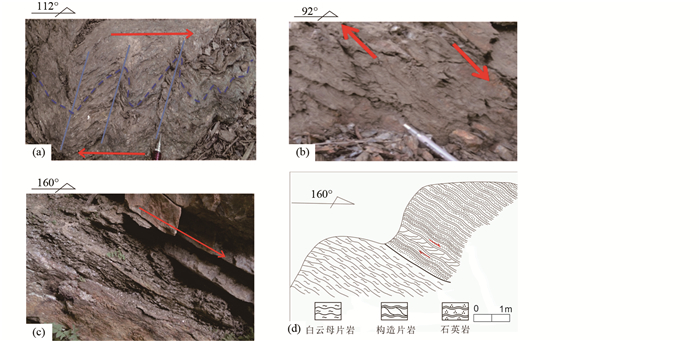
|
图 3 连山关岩体南缘变形特征 (a、b)南缘中段右行斜向走滑剪切变形,位置见图 1b②处;(c、d)南缘东段辽河群滑动方向,位置见图 1b③处 Fig. 3 Deformation characteristics of the southern margin of Lianshanguan granitic pluton (a, b) dextral oblique strike slip shear deformation in the middle of southern margin, location is shown in Fig. 1b②; (c, d) slip direction of Liaohe Group in the eastern part of southern margin, location is shown in Fig. 1b③ |
岩体东缘构造变形相对较弱。张堡村北侧(图 1b④处),重熔混合岩显示韧性剪切变形所形成的片麻理和矿物拉伸线理。片麻理产状150°~175°∠47°~61°,矿物拉伸线理产状105°∠45°。在局部相对刚性的块体内仍保留了碎屑结构,可见花岗质碎屑团块的透镜体,透镜体受剪切变形旋转拉长,指示了向E的正滑构造(图 4),总体反映了连山关花岗岩体隆起,上覆辽河群浪子山组地层向下滑动剪切的变形特征。
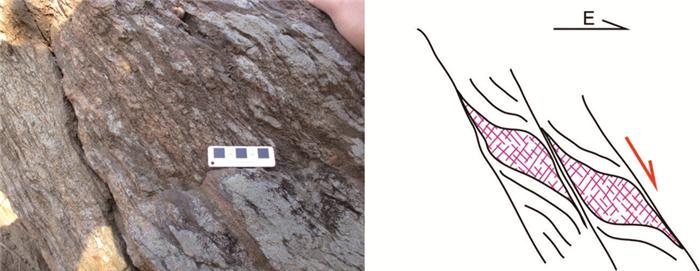
|
图 4 连山关岩体东缘顺层滑动剪切变形(位置见图 1b④处) Fig. 4 Bedding sliding shear deformation of the eastern margin of Lianshanguan granitic pluton (location is shown in Fig. 1b④) |
浪子山组位于辽河群最下部,与连山关花岗岩为韧性滑脱接触。在宏观尺度上,可见宽缓斜歪褶皱,轴向主要为NE或NEE向,形成于NW-SE向的区域性压扭性应力作用;在大北沟村(图 1b⑤处)发现浪子山组片岩发育典型的褶曲变形,小尺度的紧闭褶皱及与其相关的轴面片理,片理置换强烈(图 5a);局部还发育有小尺度的层间韧性剪切带(图 5b)。在三道岭处(图 1b①处)发现浪子山组中花岗质岩脉拉伸变形,具有典型右行剪切特征(图 5c)。

|
图 5 浪子山组变形特征 (a、b)位置见图 1b⑤处; (c)位置见图 1b①处 Fig. 5 Deformation characteristics of Langzishan Formation in the study area (a, b) location is shown in Fig. 1b⑤; (c) location is shown in Fig. 1b① |
连山关岩体南缘韧性剪切带内典型的强变形岩石样品(采样点见图 1b)的矿物组合主要包括石英、长石、白云母和黑云母,偶见有少量石榴子石发育(表 1、图 6)。矿物的显微变形代表了典型的糜棱岩组构特征,主要表现在:石英呈明显的波状消光,主要发育膨凸重结晶-亚颗粒旋转重结晶特点(图 6a, b),其S-C组构及旋转残斑均指示其剪切指向为右行剪切。长石多为碱长石,表面粗糙,具格子状双晶。长石矿物拉长不明显,取而代之的是单个矿物常发生破裂。二类云母定向明显,组成了岩石中主体片理(图 6c, d)。然而,剪切带内相对弱变形岩石中,黑云母定向不明显,呈弱片麻状构造,矿物拉长定向较弱。石英发育带状消光,扭折弯曲,膨凸重结晶等显微构造,具有初糜棱岩结构特征(图 6e, f)。
|
|
表 1 连山关岩体南缘韧性剪切带内典型变形样品显微组构特点 Table 1 Structural characteristics of the deformed rocks in the ductile shear zone along the southern margin of the Lianshanguan granitic pluton |
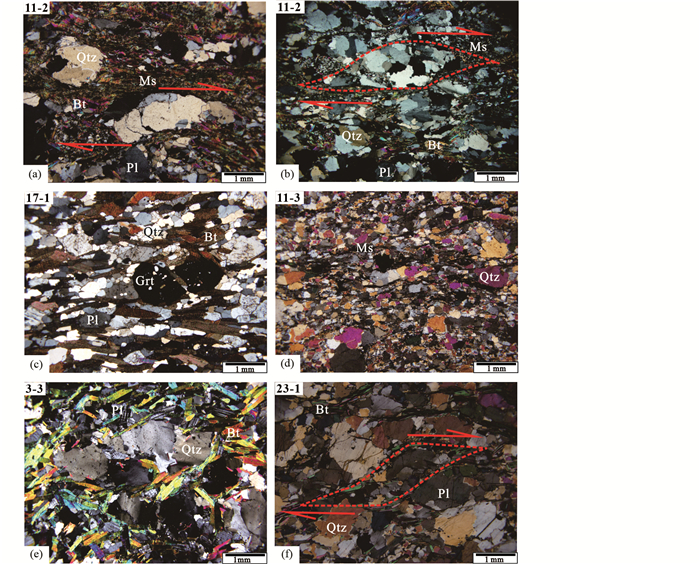
|
图 6 研究区典型样品显微照片 旋转残斑发育(a、b、f);石英表现为波状消光(a、c、e、f)和定向拉长特征(a、c).Qtz-石英; Ms-白云母; Bt-黑云母; Pl-斜长石; Grt-石榴子石 Fig. 6 Micrographs of typical samples in the study area The development of rotation residual spot (a, b, f); quartz is characterized by grain wave extinction (a, c, e, f) and directional elongation (a, c). Qtz-quartz; Ms-muscovite; Bt-biotite; Pl-plagioclase; Grt-garnet |
为确定连山关地区韧性剪切带的构造变形特征,本次研究选取了剪切带内不同部位岩石作为研究对象(采样点见图 1b),所选样品变形程度不同(图 7)。本文选用Fry法和惯量椭圆法进行有限应变测量。
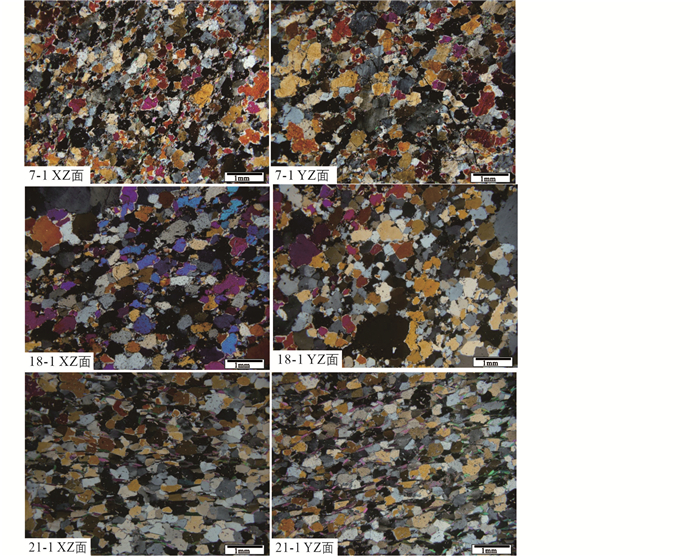
|
图 7 有限应变分析样品显微照片 Fig. 7 Micrographs of sample for limited strain analysis |
Fry法 首先对研究区岩石根据拉伸线理和面理两个主应变面,切制定向探针薄片(平行拉伸线理和垂直糜棱面理作为XZ面和平行面理为XY面),然后选取两个薄片分别进行应变测量。因本区岩石中石英含量高,粒径分布较均匀,故选择糜棱岩样品中普遍塑性拉长的石英或者石英集合体作为应变标志体。有限应变分析,对于每一个定向样品两个应变面(XZ面和YZ面)上分别测量石英标志体数目不少于50个,在显微镜下采集照片,在CorelDRAW软件中对整个视域中的石英颗粒进行统计(韩阳光等,2015)(图 8)。
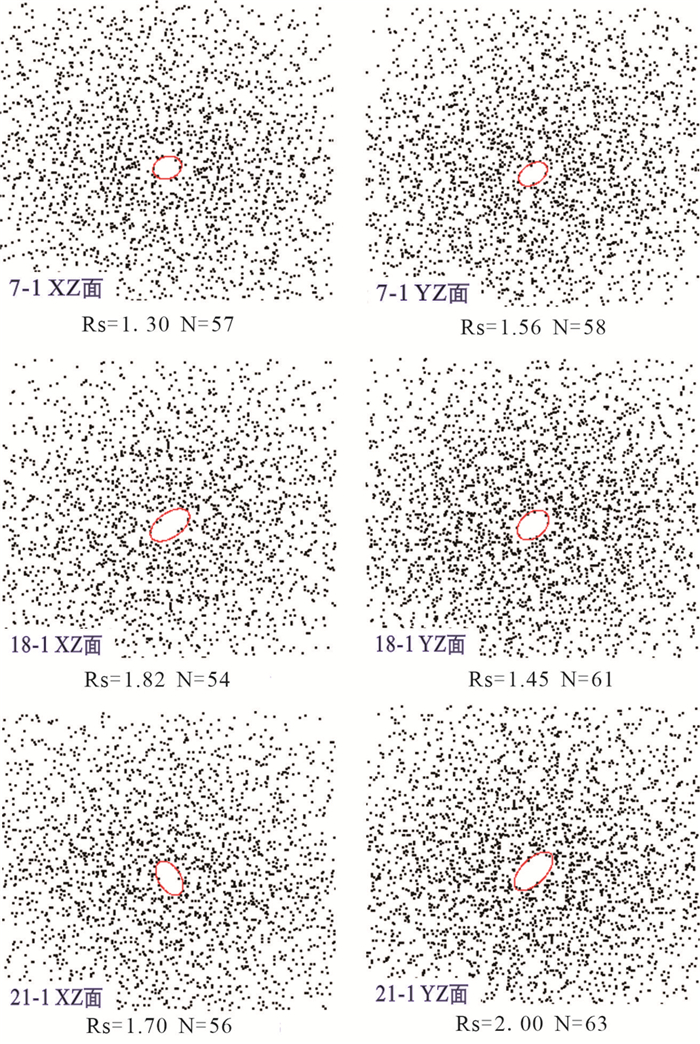
|
图 8 Fry法有限应变测量图 Rs-应变椭圆的长短轴比; N-石英标志体数目 Fig. 8 Limited strain measurement diagram of Fry method Rs-the ratio of major axis to minor axis of strain ellipse; N-number of quartz markers |
惯量椭圆法 首先对野外定向标本进行切片处理后,在定向切片上观察变形较好的石英颗粒的种类及特征,并拍照采集相关图像资料;然后在有限应变自动分析软件Straindesk的操作平台上进行测量(李志勇和曾佐勋,2006)。首先通过薄片显微照片提取变形石英颗粒边界,然后由Straindesk软件对任意形状石英颗粒边界进行模拟得到每个颗粒的应变椭圆和其有限应变值,最后,统计分析已提取的所有石英颗粒,综合后得到该岩石的三维有限应变值(图 9)。
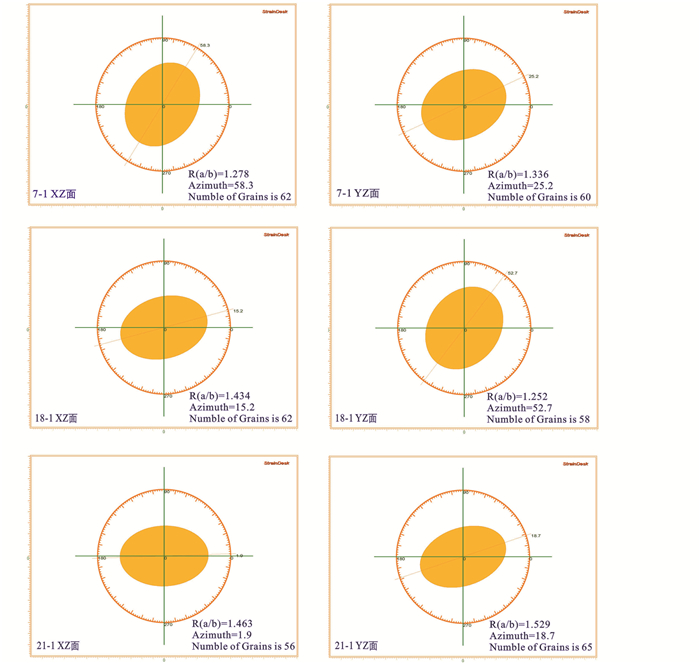
|
图 9 惯量椭圆法有限应变测量图 Fig. 9 Limited strain measurement diagrams of Inertia Ellipse method |
本次研究中对7-1、18-1和21-1等3个样品开展了有限应变测量,为增加实现结果的精确性,每组薄片中都尽可能的选择50个石英颗粒以上。不同测量方法经不同计算方法后,可得出以下测量数据(X/Y值通过换算可得),结果较为理想,Fry法和惯量椭圆法测量结果都比较集中,且较为一致(表 2),反映测量结果比较接近真实应变水平。
|
|
表 2 连山关地区样品有限应变测量数据 Table 2 Limited strain measurement data of samples in Lianshanguan area |
将上述测量数据利用Flinn图解(图 10)进行判别,得出研究区应变类型为压扁应变,K值在0.19~0.69之间,岩石类型表现为S/SL型构造岩,属于一般压缩-平面应变范围。可见,研究区韧性剪切带内矿物颗粒经历了压缩应变,结合区域右旋剪切背景,可以认为岩石在剪切力作用下发生右行剪切作用变形,发生定向压扁。因此,综合分析结果,我们认为靠近连山关岩体的样品,处于岩浆核杂岩的顶部(图 11),当岩体隆升过程中,对上覆岩体存在向上挤压作用,岩石应变类型以压扁应变为主,而处于岩浆核杂岩边部则以拉长应变为主(李建波,2010)。

|
图 10 Flinn有限应变判别图 Fig. 10 Flinn limited strain discrimination diagram |
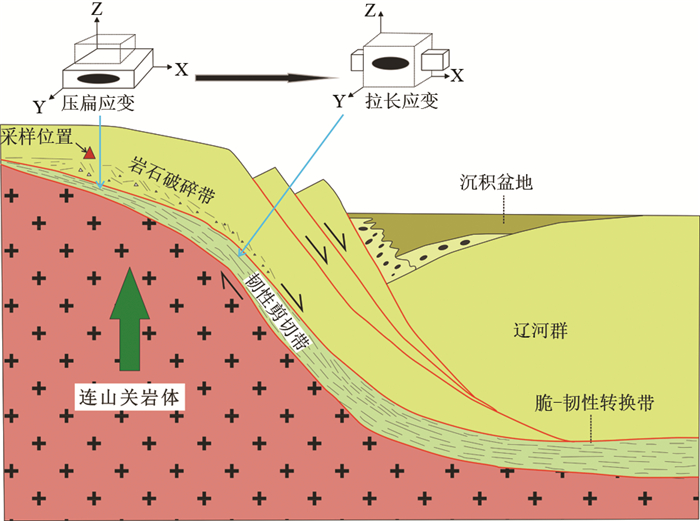
|
图 11 连山关岩体周缘韧性剪切带成因模式及不同部位应变类型 Fig. 11 Genetic model and strain types of ductile shear zone around Lianshanguan granitic pluton |
连山关铀矿(3075)位于连山关岩体南缘与辽河群接触带的中部(图 1b),四道沟至樟木之间,矿床面积0.25km2。铀矿受北东走向的小背斜控制,该背斜轴长120~140m,高60~80m,两翼宽度120m,标高180~260m;背斜由浪子山岩组一段石英岩、云母石英片岩组成,核部被重熔混合岩充填,北东仰起,南西倾伏。矿床中矿体均为隐伏盲矿体,分别产于背斜两翼,背斜轴部和背斜转折端,主矿体倾向有150°和330°两个方向,走向约60°,倾角60°~80°。在平面上矿体赋存于韧性剪切带内的北东-北东东向张性断裂中,分布在160×80m的空间内,由北西向南东雁行排列(图 12a)。在剖面上背斜两翼矿体倾向相反,背斜轴部矿体陡立,转折端矿体倾向南西。总体上矿体顶部收敛,下部撒开,中间直立,在剖面上局部呈“个”字型,主要矿体均分布在剪切带内重熔混合岩之中(图 12b)。
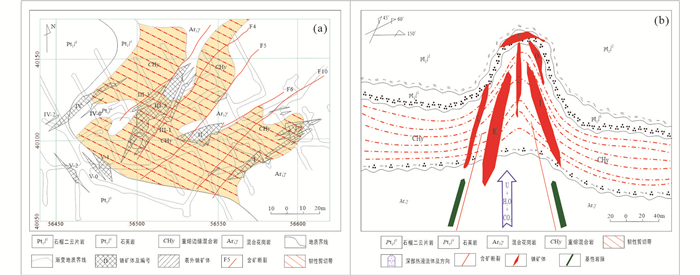
|
图 12 连山关铀矿床220m中段平面图(a)及剖面示意图(b)(据庄廷新,2009修改) Fig. 12 Plan diagram (a) and section diagram (b) of 220m level in Lianguanshan uranium deposit |
黄沟铀矿位于连山关铀矿东南约1km处(图 1b),围岩为重熔混合岩,向连山关花岗岩体内部渐变过渡,矿体逐渐变薄,品位变低至尖灭。矿床中矿体均为隐伏盲矿体,呈细脉状、透镜状、鱼群状分布,厚度一般为1.0~4.0m;矿体走向集中在60°~75°,倾向南东,倾角60°~80°。在平面上矿体分布在东西长约600m、南北宽约500m的范围内,自北西向南东雁行排列并向南西侧伏,主要赋存于韧性剪切带内及其与岩体接触部位(图 13a)。在剖面上分布于韧性剪切带内重熔混合岩异常增厚及形态变化部位,大多数矿体集中在标高0~200m空间内(图 13b)。
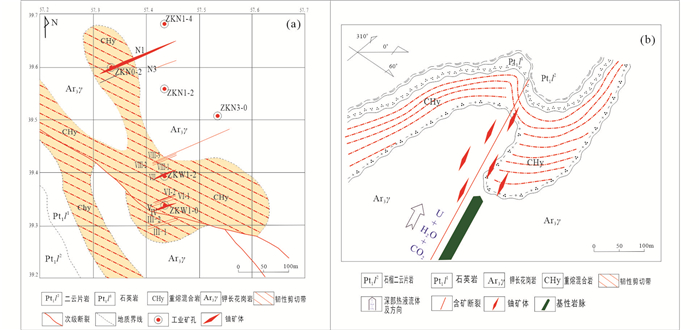
|
图 13 黄沟铀矿床160m中段平面图(a)及剖面示意图(b) Fig. 13 Plan diagram (a) and section diagram (b) of 160m level in Huanggou uranium deposit |
通过对剪切带内岩石进行宏观及微观变形特征分析,并总结了前人的研究成果(张秋生和杨振升,1988;李三忠等, 1996, 1997;刘永江等,1997;郝德峰等,2004),认为研究区总体上遭受三期主要构造变形改造。第一期构造变形主要由于区域伸展连山关岩体的隆升(裂谷期伸展背景下,张秋生和杨振升,1988),辽河群向连山关岩体的四周顺层滑脱,在辽河群内部表现为平行原始层理的顺层滑脱剪切变形,形成间隔性分布的顺层剪切带(S1)和期间夹持的层内流褶带,在流褶带内原始的S0发生紧闭的剪切褶皱,大部分被新生片理S1所置换,所以露头区所见到的面状组构一般为S0//S1,只有在变形弱的地区见有S0。这期变形为透入性的变形,在辽河群地层中普遍发育。第二期构造变形表现为近SN的挤压构造(裂谷收缩期),使原来的面理(S0//S1)形成北西向展布的褶皱,同时,在连山关花岗岩体南缘与辽河群接触带部位发生强烈的右行韧性剪切变形并伴有一些小型的呈北东和北东东向展布的褶皱。第三期为晚期挤压脆性变形,应力场方向可能为近东西向挤压,形成北东东和北西两组脆性断裂构造。
通过对连山关岩体周缘(图 1),尤其是南缘接触带产状倾角大小的分析可以看出,南缘中部产状很陡,说明南北向的挤压应力主要来自南部,由南向北的强烈挤压造成第二期的挤压变形和伴随的边缘右行走滑变形。同时,连山关岩体总体发生挤压隆起,形成由岩体边缘向四周外侧的隆升滑脱构造。
5.2 韧性剪切带和铀矿的关系韧性剪切变形作用作为一种重要的构造运动形式,对于矿床的预富集、形成及演化产生了十分重要的影响。连山关岩体及其上部辽河群的年代学研究以及构造背景分析,确定了该地区辽河群底部与太古宙花岗岩之间存在大型韧性剪切带(刘永江等,1997);其形成于古元古代早期滑脱和晚期挤压背景下,同时伴随着辽河群的变形变质作用和岩体的局部重熔(李三忠等,1998;吴迪等,2013;常瑞虹等,2017)。连山关地区铀矿空间的分布受北西向韧性剪切带控制,铀矿体定位于剪切带次级裂隙之中。
5.2.1 一级控矿构造:韧性剪切带韧性剪切带分布在连山关岩体与辽河群地层接触部位,呈狭长带状展布,主要发育在连山关岩体南缘和东北缘,剪切变形强烈,沿着周缘剪切带分布一系列矿床(点),如岩体南缘的连山关、黄沟、170、256、259、258、206等(图 1b)。因此,连山关岩体周缘的韧性剪切带(包括辽河群底部浪子山组下部和连山关岩体顶部)为铀矿的一级控矿构造。铀矿化与韧性剪切带强烈相关,已知的矿床都产于连山关岩体的周缘剪切带内,这说明剪切带构造变形是铀矿富集的一个重要机制,韧性剪切变形中热液活动可能导致铀矿化富集,或者剪切带为深部来源的成矿热液提供了上升通道和铀络合物迁移、富集的通道。
5.2.2 二级控矿构造:脆性断裂带区域性断裂构造对铀成矿有重要的控制作用,铀矿化受北西向韧性剪切带所控制,而铀矿床则定位于北西向与北东东向断裂的交汇部位。如连山关铀矿,矿体群受北东向压性入字型背斜构造所控制,而矿体则受沿小型背斜的轴向断裂构造所控制(图 12a, b)。对连山关铀矿含矿裂隙进行统计,规模较大的断裂有6条,均属次级断裂。NEE向含矿断裂在260m、220m中段极为发育,从断裂面极点等密图(图 14a)可以看出,极点对应集中于北西-南东方向,通过对连山关铀矿坑道内47个脆性破裂构造赤平投影图(图 14b)的产状统计分析表明,晚期的脆性破裂主要以北西和北东东向为主,其中以北东东向的破裂面与铀矿体的定位更为密切。含矿断裂组走向NE55°~70°,倾向南东或北西,倾角多在60°~80°之间,总体向南收敛,北东撒开,长度一般80~100m。该组断裂是主要控矿构造,沥青铀矿脉充填其中。
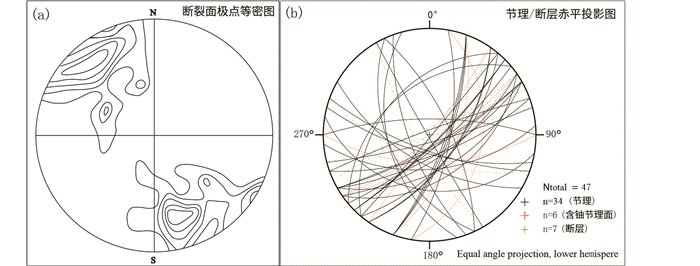
|
图 14 连山关铀矿260m中段断裂面极点等密图(a)及节理/断层赤平投影图(b) Fig. 14 Isometric map of the poles of the fault plane (a) and stereographic map of joint/fault occurrence (b) in the middle 260m of the Lianshanguan uranium deposit |
连山关岩体与上覆辽河群地层间存在明显的沉积不整合接触关系,发育有新太古代基底岩石的古老风化壳。沿着不整合界面发育的韧性剪切作用使大部分古风化壳遭受改造。区域地质背景、赋矿围岩、围岩蚀变、矿石的地质特征和地球化学特征显示,连山关铀矿的铀源应主要来自于古老的风化壳(吴迪等,2017)。区内含铀较高的太古代变质岩和花岗岩基底,经长期风化剥烛,铀被析离出来,在氧化环境下,正六价的铀以络合物的形式由流水携带,同碎屑矿物一起搬运沉积到地势相对低洼的位置,被泥质、铁质、有机质吸附从而形成古元古界底部含铀层,完成铀的初步预富集(图 15a)。古元古代晚期由于第二期南北向的强烈挤压作用,在连山关岩体南缘与辽河群地层原沉积不整合接触带部位发生了右行韧性剪切作用,来自深部的富碱热液使岩石发生了局部重熔和碱交代作用,形成了韧性剪切变形带中的重熔混合岩,在此过程中富碱热液通过碱交代使岩体中的活动铀随着热液的运移在局部发生了进一步富集(图 15b)。
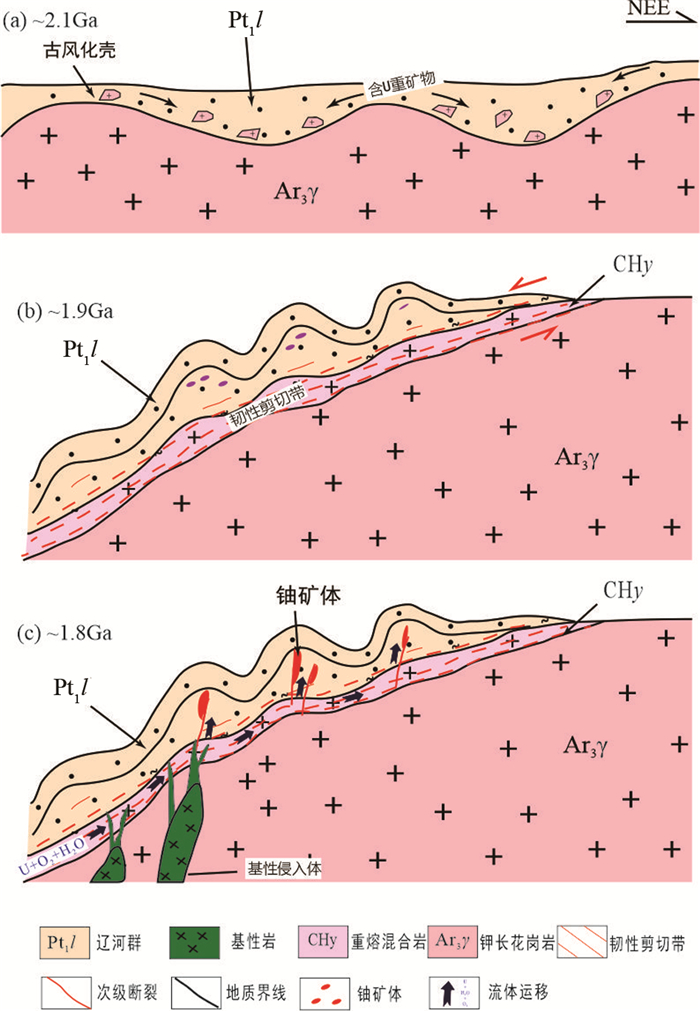
|
图 15 连山关铀矿成矿模式图 Fig. 15 Metallogenic model of Lianshanguan uranium deposit |
第三期近东西向的挤压作用,形成了一些北西、北东东向断裂构造,这些断裂与不整合面及其中发育的韧性剪切带的交汇部位,构成理想的高渗透带,可提供良好的导矿通道和储矿空间。同时基性岩墙(锆石U-Pb年龄~1.8Ga,王惠初等,2011)带来的地幔流体沿剪切裂隙上涌,为成矿提供了矿化剂和热源,富含还原剂的热液流体沿不整合面和裂隙运移,最终沉淀定位于太古代基底与上覆浪子山组褶皱核部(图 15c)。
综上研究,我们认为连山关铀矿的主要铀源应来自太古宙古老风化壳,并在大型韧性剪切活动(提供热液运移通道)和基性脉岩侵入(提供热源和还原剂)等综合因素作用下运移、富集成矿,属于古风化壳-热液型铀矿。
6 结论(1) 连山关地区总体上遭受了三期构造变形,第一期为连山关岩体隆升,辽河群向连山关岩体四周顺层滑脱剪切构造变形;第二期为近南北向挤压构造变形,形成连山关背斜穹窿南翼右行韧性剪切带;第三期为脆性断裂构造,应力场可能为近东西向挤压,形成北东东向和北西向两组脆性断裂。
(2) 连山关岩体南缘剪切构造变形比较强烈,应变类型为压扁应变,属于一般压缩-平面应变范围。K值在0.19~0.69之间,岩石类型表现为S/SL型构造岩。
(3) 连山关岩体南缘北西向韧性剪切带为一级控矿构造,是铀矿流体运移的通道;北东东向二级构造断裂则是铀矿储存空间。
致谢 衷心感谢中国科学院地质与地球物理研究所曾庆栋研究员和中山大学刘锦博士提出的宝贵修改意见;感谢陈昭旭博士在修改图件方面给予的帮助!
谨以此文祝贺杨振升教授九十华诞,祝杨先生健康长寿!
Bonnemaison M and Marcoux E. 1990. Auriferous mineralization in some shear-zones:A three-stage model of metallogenesis. Mineralium Deposita, 25(2): 96-104 |
Boullier AM and Robert F. 1992. Palaeoseismic events recorded in Archaean gold-quartz vein networks, Val d'Or, Abitibi, Quebec, Canada. Journal of Structural Geology, 14(2): 161-179 DOI:10.1016/0191-8141(92)90054-Z |
Boyle RW. 1979. The Geochemistry of Gold and Its Deposits. Ottawa: Geological Survey of Canada, 1-584
|
Cai XL, Cao JM, Zhu JS and Cheng XQ. 2008. The system of crust-mantle ductile shear zones in China continental lithosphere. Earth Science Frontiers, 15(3): 36-54 (in Chinese with English abstract) |
Chang RH, Li WM, Liu YJ, Liang CY, Li J, Zhang L, Liu XY and Fan WL. 2017. Structural properties and kinematic analysis of Lianshanguan ductile shear zone in northern Liao-Ji Rift Zone, northeastern North China Craton. Earth Science, 42(12): 2193-2207 (in Chinese with English abstract) |
Chen B, Li Z, Wang JL, Zhang L and Yan XL. 2016. Liaodong Peninsula ~2.2Ga magmatic event and its geological significance. Journal of Jilin University (Earth Science Edition), 46(2): 303-320 (in Chinese with English abstract) |
Chen BL, Dong XF and Li ZJ. 1999. Ore-forming model of ductile shear zone type gold deposits. Geological Review, 45(2): 186-192 (in Chinese with English abstract) |
Chen BL, Yang N, Wu GG, Ye DJ, Liu XC and Shu B. 2002. Analysis of ore-controlling structure in ductile shear zone type gold deposits in southern Beishan Area, Gansu Province. Mineral Deposits, 21(2): 149-158 (in Chinese with English abstract) |
Chen F, Yan DP, Qiu L, Yang WX, Tang SL, Guo QY and Zhang YX. 2019. The brittle-ductile shearing and uranium metallogenesis of the Motinaling dome in the southwestern Jiangnan Orogenic Belt. Acta Petrologica Sinica, 35(9): 2637-2659 (in Chinese with English abstract) DOI:10.18654/1000-0569/2019.09.02 |
Chen RD. 1984. An Early Proterozoic rift basin:Liaodong rift. Liaoning Geology, (2): 125-133 (in Chinese) |
Chen RD. 1990. The tectonic evolution of the Liaodong Rift. Regional Geology of China, 333(4): 306-315, 333 (in Chinese with English abstract) |
Dong CJ. 2012. Geological characteristics of the deposits and analysis of the mineralization system of Qingchengzi Pb-Zn-Au-Ag polymetallic ore field. Ph. D. Dissertation. Beijing: China University of Geosciences (Beijing) (in Chinese with English summary)
|
Dong CL and Xue ST. 1992. On the geological conditions in searching for Precambrian unconformity-related and stratabound uranium deposits in East Liaoning region. Uranium Geology, (1): 20-25 (in Chinese with English abstract) |
Dong HQ. 2018. Deformation characteristics of ductile shear zone in Baishan area, Ruoqiang County, Xinjiang. Master Degree Thesis. Beijing: China University of Geosciences (Beijing) (in Chinese with English summary)
|
Duan JR, He SX and Zhou CZ. 1992. Shear zone type gold deposit:A case study of Hetai gold deposit, Guangdong Province. Geology and Exploration, (6): 6-11 (in Chinese) |
Gu DL, Hu L and Zhang XT. 1998. Mass balance analysis of mylonite in the Eshankou ductile shear zone. Regional Geology of China, 17(2): 149-155 (in Chinese with English abstract) |
Guo CY, Han J, Xu H, Bai Y, Ren ZB, Han Y and Zhao YT. 2018. Tectonic settings of Paleoproterozoic hydrothermal uranium deposits in eastern Liaoning Province, China. Geotectonica et Metallogenia, 42(5): 893-907 (in Chinese with English abstract) |
Guo ZT. 1982. Geological characteristics and genesis model of Lianshangun uranium deposit in eastern Liaoning Province, China. Journal of Changchun College of Geology, (Suppl.1): 84-95 (in Chinese with English abstract) |
Guo ZT. 1986. The Precambrian crustal evolution and mineralization cycle of uranium in the northeast of northern China platform. Uranium Geology, 2(4): 200-209 (in Chinese with English abstract) |
Han YG, Yan DP and Li ZL. 2015. A new solution for finite strain measurement by fry method in the CorelDRAW platform. Geoscience, 29(3): 494-500 (in Chinese with English abstract) |
Hao DF, Li SZ, Zhao GC, Sun M, Han ZS and Zhao GT. 2004. Origin and its constraint to tectonic evolution of Paleoproterozoic granitoids in the eastern Liaoning and Jilin provinces, North China. Acta Petrologica Sinica, 20(6): 1409-1416 (in Chinese with English abstract) |
He YN, Shi LB and Lin CY. 1988. Ductile shear zones and their deformed rocks. Seismology and Geology, 10(4): 69-76 (in Chinese with English abstract) |
Kolb J. 2008. The role of fluids in partitioning brittle deformation and ductile creep in auriferous shear zones between 500 and 700℃. Tectonophysics, 446(1-4): 1-15 DOI:10.1016/j.tecto.2007.10.001 |
Li JB. 2010. Strain, kinematic vorticity analysis and ductile thinning of the ductile detachment zone of metamorphic core complex in North China Craton. Ph. D. Dissertation. Beijing: Chinese Academy of Geological Sciences (in Chinese with English summary)
|
Li JB, Wang T, Guo L, Tong Y, Ouyang ZX, Zeng T, Shi XJ and Zhang JJ. 2012. The shear types and the ductile thinning of the ductile shear zone. Geological Bulletin of China, 31(1): 26-37 (in Chinese with English abstract) |
Li SZ, Yang ZS and Liu YJ. 1996. Preliminary analysis on uplift bedding delamination structure of the Palaeoproterozoic orogenic belt in Liaodong Peninsula. Journal of Changchun University of Earth Sciences, 26(3): 305-309 (in Chinese with English abstract) |
Li SZ, Yang ZS, Liu YJ and Liu JL. 1997. Emplacement model of Palaeoproterozoic early-granite in Jiao-Liao-Ji area and its relation to the uplift bedding-delamination structural series. Acta Petrologica Sinica, 13(2): 189-202 (in Chinese with English abstract) |
Li SZ, Liu YJ, Yang ZS and Ma R. 1998. Relations between deformation and metamorphic recrystallization in metaperlite of Liaohe Group. Acta Petrologica Sinica, 14(3): 351-365 (in Chinese with English abstract) |
Li SZ, Han ZZ, Liu YJ and Yang ZS. 2001. Constraints of geology and geochemistry on Paleoproterozoic pre-orogenic deep processes in Jiao-Liao Massif. Chinese Journal of Geology, 36(2): 184-194 (in Chinese with English abstract) |
Li SZ, Zhao GC, Sun M, Han ZZ, Zhao GT and Hao DF. 2006. Are the South and North Liaohe groups of North China Craton different exotic terranes? Nd isotope constraints. Gondwana Research, 9(1-2): 198-208 DOI:10.1016/j.gr.2005.06.011 |
Li SZ and Zhao GC. 2007. SHRIMP U-Pb zircon geochronology of the Liaoji granitoids:Constraints on the evolution of the Paleoproterozoic Jiao-Liao-Ji belt in the Eastern Block of the North China Craton. Precambrian Research, 158(1-2): 1-16 DOI:10.1016/j.precamres.2007.04.001 |
Li XF, Wang CZ, Yi XK, Feng ZH and Wang YT. 2007. Deformation structures at various scales and their roles during gold mineralization at Jinshan gold deposit, Jiangxi Province. Geological Review, 53(6): 774-782 (in Chinese with English abstract) |
Li ZY and Zeng ZX. 2006. Finite strain measurement of rocks by using of inertia moment ellipses. Geological Science and Technology Information, 25(6): 37-40 (in Chinese with English abstract) |
Lian LX. 1989. A comparison of uranium metallogenetic conditions between Lianshanguan in China and the East Alligator River area in Australia. Uranium Geology, 6(4): 221-225 (in Chinese with English abstract) |
Liang L, Li JH and Liu CD. 2019. Feature of mylonite belt and its relation to granite-type uranium deposit in northern Guangdong metallization cluster. Uranium Geology, 35(2): 73-79 (in Chinese with English abstract) |
Lin CY, He YN and Shi LB. 1992. Ductile Shear and Brittle Ductile Transformation of Rocks. Beijing: Geological Publishing House, 183-190 (in Chinese)
|
Liu DY, Nutman AP, Compston W, Wu JS and Shen QH. 1992. Remnants of ≥ 3800Ma crust in the Chinese part of the Sino-Korean Craton. Geology, 20(4): 339-342 DOI:10.1130/0091-7613(1992)020<0339:ROMCIT>2.3.CO;2 |
Liu DY, Wilde SA, Wan YS, Wu JS, Zhou HY, Dong CY and Yin XY. 2008. New U-Pb and Hf isotopic data confirm Anshan as the oldest preserved segment of the North China Craton. American Journal of Science, 308(3): 200-231 DOI:10.2475/03.2008.02 |
Liu DZ. 1990. Main ore-hosting factor and prospecting direction of the Early Proterozoic rich uranium deposit in the Lianshanguan area of East Liaoning. Uranium Geology, 6(4): 193-202 (in Chinese with English abstract) |
Liu FL, Liu PH, Wang F, Liu CH and Cai J. 2015. Progresses and overviews of voluminous meta-sedimentary series within the Paleoproterozoic Jiao-Liao-Ji orogenic/mobile belt, North China Craton. Acta Petrologica Sinica, 31(10): 2816-2846 (in Chinese with English abstract) |
Liu J, Liu ZH, Zhao C, Wang CJ, Peng YB and Zhang H. 2017. Petrogenesis and zircon LA-ICP-MS U-Pb dating of newly discovered Mesoarchean gneisses on the northern margin of the North China Craton. International Geology Review, 59(12): 1575-1589 DOI:10.1080/00206814.2017.1285729 |
Liu J, Zhang J, Liu ZH, Yin CQ, Zhao C, Li Z, Yang ZJ and Dou SY. 2018. Geochemical and geochronological study on the Paleoproterozoic rock assemblage of the Xiuyan region:New constraints on an integrated rift-and-collision tectonic process involving the evolution of the Jiao-Liao-Ji Belt, North China Craton. Precambrian Research, 310: 179-197 DOI:10.1016/j.precamres.2018.03.005 |
Liu J, Zhang J, Yin CQ, Cheng CQ, Liu XG, Zhao C, Chen Y and Wang X. 2020. Synchronous A-type and adakitic granitic magmatism at ca. 2.2Ga in the Jiao-Liao-Ji belt, North China Craton:Implications for rifting triggered by lithospheric delamination. Precambrian Research, 342: 105629 DOI:10.1016/j.precamres.2020.105629 |
Liu JS. 1996. Some problems in the study of gold mineralization in ductile shear zones. Geological Review, 42(2): 123-128 (in Chinese with English abstract) |
Liu JX. 2019. The Mesozoic tectonic evolution of Liaodong area in the eastern segment of the northern margin of the North China Craton. Ph. D. Dissertation. Changchun: Jilin University (in Chinese with English summary)
|
Liu RX. 1988. Microstructural Geology. Beijing: Peking University Press, 3-30 (in Chinese)
|
Liu YJ, Li SZ and Yang ZS. 1997. Early Proterozoic uplift-slide structural model on the eastern margin of the North China platform. Geological Review, 43(6): 569-576 (in Chinese with English abstract) |
Liu ZY, Guo CY, Hao RX, Du LT and Bai Y. 2019. Mineralization characteristics of No. 3075 uranium deposit. Journal of East China Institute of Technology, 42(1): 8-15 (in Chinese with English abstract) |
Lu TJ. 2019. Tectonic deformation and evolution of Liaohe Group in Lianshanguan area, Liaodong Peninsula. Master Degree Thesis. Beijing: China University of Geosciences (Beijing) (in Chinese with English summary)
|
Luo Y, Sun M, Zhao GC, Li SZ, Ayers JC, Xia XP and Zhang JH. 2008. A comparison of U-Pb and Hf isotopic compositions of detrital zircons from the North and South Liaohe groups:Constraints on the evolution of the Jiao-Liao-Ji Belt, North China Craton. Precambrian Research, 163(3-4): 279-306 DOI:10.1016/j.precamres.2008.01.002 |
Montési LGJ. 2013. Fabric development as the key for forming ductile shear zones and enabling plate tectonics. Journal of Structural Geology, 50: 254-266 DOI:10.1016/j.jsg.2012.12.011 |
Nie JT, Fan HH, Zhang JL, Gao Y, Chen DH, Wang SY and Wang JH. 2013. Characters of structural geology and ore-controlling factors in EPL3602 area, Midwest Namibia. Uranium Geology, 29(4): 223-230 (in Chinese with English abstract) |
Qin Y, Chen DD, Liang YH, Zou CM, Zhang QW and Bai LA. 2014. Geochronology of Ji'an Group in Tonghua area, southern Jilin Province. Earth Science, 39(11): 1487-1499 (in Chinese with English abstract) |
Qiu L, Yan DP, Ren MH, Cao WT, Tang SL, Guo QY, Fan LT, Qiu JT, Zhang YX and Wang YW. 2018. The source of uranium within hydrothermal uranium deposits of the Motianling mining district, Guangxi, South China. Ore Geology Reviews, 96: 201-217 DOI:10.1016/j.oregeorev.2018.04.001 |
Ramsay JG and Graham RH. 1970. Strain variation in shear belts. Canadian Journal of Earth Sciences, 7(3): 786-813 DOI:10.1139/e70-078 |
Ramsay JG. 1980. Shear zone geometry:A review. Journal of Structural Geology, 2(1-2): 83-99 DOI:10.1016/0191-8141(80)90038-3 |
Roberts RG. 1987. Ore deposit model #11:Archean lode gold deposits. Geoscience Canada, 14(1): 37-52 |
Shen BF, Zhang K and Bi JH. 2020. Geological characteristics of double metallogenic belts in Paleoproterozoic Liaoji active belt. Mineral Deposits, 39(1): 1-18 (in Chinese with English abstract) |
Shu LS, Sun Y, Wang DZ, Faure M, Charvet J and Monie P. 1998. Mesozoic doming extensional tectonics of Wugongshan, South China. Science in China (Series D), 28(5): 431-438 (in Chinese) |
Sibson RH. 1977. Fault rocks and fault mechanisms. Journal of the Geological Society, 133(1): 191-213 |
Sibson RH, Robert F and Poulsen KH. 1988. High-angle reverse faults, fluid-pressure cycling, and mesothermal gold-quartz deposits. Geology, 16(6): 551-555 DOI:10.1130/0091-7613(1988)016<0551:HARFFP>2.3.CO;2 |
Song B, Nutman AP, Liu DY and Wu JS. 1996. 3800 to 2500Ma crustal evolution in the Anshan area of Liaoning Province, northeastern China. Precambrian Research, 78(1-3): 79-94 DOI:10.1016/0301-9268(95)00070-4 |
Song JC. 2011. Minerogenetic series and ore-forming processes of metal deposits in the Liaodong Rift. Ph. D. Dissertation. Shenyang: Northeast University (in Chinese with English summary)
|
Sun Y, Shen XZ, Huang ZJ and Jia D. 1986. Two kinds of characterized mylonites and their genesis and geologic significance. Seismology and Geology, 8(4): 63-69 (in Chinese with English abstract) |
Sun Y, Zhu WB, Guo JC, Liu DL and Kosaka K. 2001. A review of the mylonite. Geological Journal of China Universities, 7(4): 369-378 (in Chinese with English abstract) |
Tong GY, Liu XC and Shen BW. 2012. Geological conditions and prospecting direction of uranium mineralization in Lianshanguan area, Liaoning Province. Science and Technology Innovation Herald, (1): 11-13 (in Chinese) |
Wan CL. 1997. Mineralization characteristics and mineralization control of the Jinshan gold deposit. Jiangxi Geology, 11(3): 2-7 (in Chinese with English abstract) |
Wang CZ, Li XF and Yi XK. 2009. Gold mineralization during progressive deformation in Jinshan ductile shear zone, Jinshan gold deposit, Jiangxi Province:Evidence from Microscopic deformation structures. Journal of Guilin University of Technology, 29(2): 169-182 (in Chinese with English abstract) |
Wang HC, Lu SN, Chu H, Xiang ZQ, Zhang CJ and Liu H. 2011. Zircon U-Pb age and tectonic setting of meta-basalts of Liaohe Group in Helan Area, Liaoyang, Liaoning Province. Journal of Jilin University (Earth Science Edition), 41(5): 1323-1333 (in Chinese with English abstract) |
Wang J and Du LT. 1988. Geological and geochemical features of the Early Proterozoic Lianshanguan uranium deposit Liaoning Province, Northeast China. Uranium Geology, 4(6): 321-331 (in Chinese with English abstract) |
Wang JC, Li S, Yu H, Wang SL, Tang JR, Xiong B, Wang XY, Wang FL and Li TD. 2020. Three-stage structural mineralization model for ductile shear zone related gold deposits:A case study of the Hetai gold deposit, Guangdong, South China. Geotectonica et Metallogenia, 44(1): 20-29 (in Chinese with English abstract) |
Wang ZQ, Li ZY, Wu LQ and Chen GS. 2010. Geochemical evidences for mantle-derived uranium metallogenesis:A case study of Xiaoshui intersection-type uranium deposit in Xiazhuang area. Uranium Geology, 26(1): 24-34 (in Chinese with English abstract) |
Wei CS and Zhai YS. 1996. Review on rock fracturing, fluid flow and accumulation of ore-forming element in the temporal-spatial segment of brittle-ductile transition. World Geology, 15(3): 1-6 (in Chinese with English abstract) |
Wei XL. 1996. The geological characteristics of Jinshan ductile shear zone-type gold deposit in Jiangxi. Geology of Jiangxi, 10(1): 52-64 (in Chinese with English abstract) |
Wu D, Zhuang TX, Liu XD and Wang C. 2013. Petrological and geochemical characteristics of remelting chorismite in Lianshanguan area of east Liaoning. World Nuclear Geoscience, 30(4): 210-216 (in Chinese with English abstract) |
Wu D, Zhuang TX, Tian L, Liu XD and Li WM. 2017. Geological features and ore genesis of Huanggou uranium deposit in eastern Liaoning uranium metallogenic belt. Journal of Jilin University (Earth Science Edition), 47(2): 452-463 (in Chinese with English abstract) |
Xia YL and Han J. 2008. Uranium ore-forming ages of the oldest uranium deposits in China and the tracing of uranium metallogenic provinces with lead isotopes. Acta Geoscientica Sinica, 29(6): 752-760 (in Chinese with English abstract) |
Xiao Y. 2001. Brittle-ductile shear zone in Jinshan gold field and its ore-forming model. Mineral Resources and Geology, 15(Suppl.1): 424-430 (in Chinese with English abstract) |
Xu W. 2019. Geochemical and geochronological insights into the tectonic evolution of the Paleoproterozoic Jiao-Liao-Ji Belt, Sino-Korean Craton. Ph. D. Dissertation. Beijing: Chinese Academy of Geosciences (in Chinese with English summary)
|
Xu ZQ. 1984a. Crustal Deformation and Microstructure. Beijing: Geological Publishing House, 5-30 (in Chinese)
|
Xu ZQ. 1984b. Major deformation features of the Alpine chain and the Himalayan chain in the Alpine cycle. Bulletin of the Chinese Academy of Geological Sciences, (9): 87-97 (in Chinese with English abstract) |
Xu ZQ and Cui JW. 1996. Tectonic Dynamics of Continental Mountain Chain Deformation. Beijing: Metallurgical Industry Press, 10-36 (in Chinese)
|
Xue JX, Liu ZH, Liu JX, Dong XJ, Feng F and Lian GH. 2020. Geochemistry, geochronology, Hf isotope and tectonic significance of Late Jurassic Huangdi pluton in Xiuyan, Liaodong Peninsula. Earth Science, 45(6): 2030-2043 (in Chinese with English abstract) |
Yan DP, Zhou MF, Song HL and Fu ZR. 2003a. Structural style and tectonic significance of the Jianglang dome in the eastern margin of the Tibetan Plateau, China. Journal of Structural Geology, 25(5): 765-779 DOI:10.1016/S0191-8141(02)00059-7 |
Yan DP, Zhou MF, Song HL, Fu ZR and Sun M. 2003b. Tectonic controls on the formation of the Liwu Cu-rich sulfide deposit in the Jianglang dome, SW China. Resource Geology, 53(2): 89-100 DOI:10.1111/j.1751-3928.2003.tb00161.x |
Yang FP. 2010. Analysis of uranium metallogenic geological conditions in Lianshanguan area, Benxi County, Liaoning Province. Science and Technology for Development, (Suppl.1): 44-3 (in Chinese) |
Yang XP, Yu XQ, Wang ZQ, Xiao WF and Zhou X. 2015. Comparative study on ore-forming conditions and sources of the hydrothermal gold deposits in the Chinese western Tianshan. Geotectonica et Metallogenia, 39(4): 633-646 (in Chinese with English abstract) |
Yang XY. 2005. On the studies of ductile shear zones:Their geological significance. Advances in Earth Science, 20(7): 765-771 (in Chinese with English abstract) |
Yin MH, Xu ZQ, Tian JM, Zhang CJ and Song H. 2019. Study on the metallogenic characteristics of the mixed rock type uranium deposits in the Kangdian axis. In: Abstracts of the 9th National Symposium on Metallogenic Theory and Prospecting Methods. Nanjing: Mineral Deposit Geochemistry Committee of the Chinese Society of Mineral and Petrogeochemistry, Mineral Deposit Geology Committee of Chinese Geological Society, State Key Laboratory of Deposit Geochemistry, Institute of Geochemistry, Chinese Academy of Sciences, 171-172 (in Chinese)
|
Zeng QD, Wang ZC, He HY, Wang YB, Zhang S and Liu JM. 2014. Multiple isotope composition (S, Pb, H, O, He, and Ar) and genetic implications for gold deposits in the Jiapigou gold belt, Northeast China. Mineralium Deposita, 49(1): 145-164 DOI:10.1007/s00126-013-0475-2 |
Zeng QD, Wang YB, Yang JH, Guo YP, Yu B, Zhou LL and Qiu HC. 2020. Spatial-temporal distribution and tectonic setting of gold deposits in the northern margin gold belt of the North China Craton. International Geology Review DOI:10.1080/00206814.2020.1737839 |
Zhai AM, Shen BF, Yang CL, Hu XD, Cao XL and Gong XH. 2005. Geological evolvement and ore-forming of the Liaoning-Jilin Paleoproterozoic rift. Geological Survey and Research, 28(4): 213-220 (in Chinese with English abstract) |
Zhai MG. 2010. Tectonic evolution and metallogenesis of North China Craton. Mineral Deposits, 29(1): 24-36 (in Chinese with English abstract) |
Zhai MG. 2011. Cratonization and the ancient North China Continent:A summary and review. Science China (Earth Sciences), 54(8): 1110-1120 DOI:10.1007/s11430-011-4250-x |
Zhai MG. 2019. Tectonic evolution of the North China Craton. Journal of Geomechanics, 25(5): 722-745 (in Chinese with English abstract) |
Zhang JF. 1990. Study on mineralization of uranium deposits. Master Degree Thesis. Beijing: Institute of Nuclear Industry Geology (in Chinese)
|
Zhang JF and Xu GQ. 1994. Studies on geneses of Lianshanguan granites and Lianshanguan uranium ore deposit. China Nuclear Science and Technology Report, (Suppl.1): 37-38 (in Chinese with English abstract) |
Zhang P, Li B, Li J, Chai P, Wang XJ, Sha DM and Shi JM. 2016. Re-Os isotopic dating and its geological implication of gold bearing pyrite from the Baiyun gold deposit in Liaodong Rift. Geotectonica et Metallogenia, 40(4): 731-738 (in Chinese with English abstract) |
Zhang QS. 1987. Early Proterozoic crustal evolution of the East Liaoning Peninsula. Bulletin of the Chinese Academy of Geological Science, (16): 155-163 (in Chinese with English abstract) |
Zhang QS and Yang ZS. 1988. Early Crust and Deposits in Liaodong Peninsula. Beijing: Geological Publishing House, 1-546 (in Chinese)
|
Zhang XF. 2015. Research on the Sibao ductile shear zone, northern Guangxi. Ph. D. Dissertation. Beijing: China University of Geosciences (Beijing) (in Chinese with English summary)
|
Zhang XY, Wu TJ, Wang ZH and Shao ZF. 2015. Study on the "Trinity" metallogenic model of Lianshanguan uranium deposit and analysis of their near peripheral prospecting prospect. In: Proceedings of 2015 Annual Meeting of China Nuclear Society Volume 1 (Uranium Geology Sub Volume, Uranium Mining and Metallurgy Sub Volume). Mianyang: China Nuclear Society, 97-102 (in Chinese)
|
Zhang ZQ and Qu XL. 2001. Prospecting potential analysis of unconformable vein super-large uranium deposits in East Liaoning Province. Geology and Resources, 10(3): 172-175 (in Chinese with English abstract) |
Zhao GC, Sun M, Wilde SA and Li SZ. 2005. Late Archean to Paleoproterozoic evolution of the North China Craton:Key issues revisited. Precambrian Research, 136(2): 177-202 DOI:10.1016/j.precamres.2004.10.002 |
Zheng YD and Chang ZZ. 1985. Finite Strain Measurement and Ductile Shear Zone of Rock. Beijing: Geological Publishing House, 1-60 (in Chinese)
|
Zhong JR. 1983. Relationship of uranium mineralization to migamtitic metasomatism in Lower Proterozoic strata in Lianshanguan area, Liaoning Province. Mineral Deposits, 2(2): 77-86 (in Chinese with English abstract) |
Zhou YH, Zhang J, Xu S and Li SY. 2011. Assessment of geochemical blocks of boron in Liaodong Rift. Journal of Jilin University (Earth Science Edition), 41(Suppl.1): 98-105 (in Chinese with English abstract) |
蔡学林, 曹家敏, 朱介寿, 程先琼. 2008. 中国大陆岩石圈壳幔韧性剪切带系统. 地学前缘, 15(3): 36-54. |
常瑞虹, 李伟民, 刘永江, 梁琛岳, 李婧, 张丽, 刘昕悦, 范文亮. 2017. 辽吉裂谷带北缘连山关韧性剪切带的构造属性和运动学分析. 地球科学, 42(12): 2193-2207. |
陈斌, 李壮, 王家林, 张璐, 鄢雪龙. 2016. 辽东半岛~2.2Ga岩浆事件及其地质意义. 吉林大学学报(地球科学版), 46(2): 303-320. |
陈柏林, 董法先, 李中坚. 1999. 韧性剪切带型金矿成矿模式. 地质论评, 45(2): 186-192. |
陈柏林, 杨农, 吴淦国, 叶得金, 刘晓春, 舒斌. 2002. 甘肃北山南带韧性剪切带型金矿床构造控矿解析. 矿床地质, 21(2): 149-158. |
陈峰, 颜丹平, 邱亮, 杨文心, 汤双立, 郭庆银, 张翼西. 2019. 江南造山带西南段摩天岭穹隆脆韧性剪切与铀成矿作用. 岩石学报, 35(9): 2637-2659. |
陈荣度. 1984. 一个早元古代裂谷盆地——辽东裂谷. 辽宁地质, (2): 125-133. |
陈荣度. 1990. 辽东裂谷的地质构造演化. 中国区域地质, 333(4): 306-315, 333. |
董存杰. 2012.青城子铅锌金银多金属矿田矿床地质特征及成矿系统分析.博士学位论文.北京: 中国地质大学(北京)
|
董春林, 薛树桐. 1992. 试谈辽东地区寻找前寒武纪不整合脉型和层控型铀矿床的地质条件. 铀矿地质, (1): 20-25. |
董浩强. 2018.新疆若羌县白山地区韧性剪切带的变形特征分析.硕士学位论文.北京: 中国地质大学(北京)
|
段嘉瑞, 何绍勋, 周崇智. 1992. 剪切带型金矿——以广东河台金矿为例. 地质与勘探, (6): 6-11. |
顾德林, 胡玲, 张雪亭. 1998. 山东沂水峨山口韧性剪切带糜棱岩类质量平衡分析. 中国区域地质, 17(2): 149-155. |
郭春影, 韩军, 徐浩, 白芸, 任忠宝, 韩愉, 赵宇霆. 2018. 辽东古元古代热液铀矿床形成的大地构造背景. 大地构造与成矿学, 42(5): 893-907. |
郭智添. 1982. 辽东连山关早前寒武纪铀矿床地质特征及成矿模式. 长春地质学院学报, (增1): 84-95. |
郭智添. 1986. 华北地台东北部前寒武纪地壳演化与铀成矿旋回. 铀矿地质, 2(4): 200-209. |
郝德峰, 李三忠, 赵国春, 孙敏, 韩宗珠, 赵广涛. 2004. 辽吉地区古元古代花岗岩成因及对构造演化的制约. 岩石学报, 20(6): 1409-1416. |
韩阳光, 颜丹平, 李政林. 2015. 在CorelDraw平台上进行Fry法有限应变测量的新技术. 现代地质, 29(3): 494-500. |
何永年, 史兰斌, 林传勇. 1988. 韧性剪切带及其变形岩石. 地震地质, 10(4): 69-76. |
李建波. 2010.华北克拉通北缘变质核杂岩韧性拆离带的应变、运动学涡度分析与韧性减薄量.博士学位论文.北京: 中国地质科学院
|
李建波, 王涛, 郭磊, 童英, 欧阳志侠, 曾涛, 史兴俊, 张建军. 2012. 韧性剪切带的剪切作用类型和韧性减薄量. 地质通报, 31(1): 26-37. |
李三忠, 杨振升, 刘永江. 1996. 辽东早元古造山带隆-滑构造初析. 长春地质学院学报, 26(3): 305-309. |
李三忠, 杨振升, 刘永江, 刘俊来. 1997. 胶辽吉地区古元古代早期花岗岩的侵位模式及其与隆滑构造的关系. 岩石学报, 13(2): 189-202. |
李三忠, 刘永江, 杨振升, 马瑞. 1998. 辽河群变质泥质岩中变质重结晶作用和形作用的关系. 岩石学报, 14(3): 351-365. |
李三忠, 韩宗珠, 刘永江, 杨振升. 2001. 胶辽地块古元古代前造山期深部过程的地质与地球化学制约. 地质科学, 36(2): 184-194. |
李晓峰, 王春增, 易先奎, 冯佐海, 王义天. 2007. 德兴金山金矿田不同尺度构造特征及其与成矿作用的关系. 地质论评, 53(6): 774-782. |
李志勇, 曾佐勋. 2006. 利用惯量椭圆进行岩石有限应变分析. 地质科技情报, 25(6): 37-40. |
连立祥. 1989. 我国连山关与澳大利亚东阿利盖特河铀成矿条件对比. 铀矿地质, 6(4): 221-225. |
梁良, 李建红, 刘成东. 2019. 粤北花岗岩型铀矿矿集区糜棱岩带特征及其与铀成矿的关系. 铀矿地质, 35(2): 73-79. |
林传勇, 何永年, 史兰斌. 1992. 岩石的韧性剪切和脆-韧性转换变形. 北京: 地质出版社, 183-190.
|
刘德正. 1990. 辽东连山关地区早元古代富铀矿床的主导赋矿因素与找矿方向. 铀矿地质, 6(4): 193-202. |
刘福来, 刘平华, 王舫, 刘超辉, 蔡佳. 2015. 胶-辽-吉古元古代造山/活动带巨量变沉积岩系的研究进展. 岩石学报, 31(10): 2816-2846. |
刘继顺. 1996. 韧性剪切带中金成矿研究的若干问题. 地质论评, 42(2): 123-128. |
刘杰勋. 2019.华北克拉通北缘东段辽东地区中生代构造演化.博士学位论文.长春: 吉林大学
|
刘瑞珣. 1988. 显微构造地质学. 北京: 北京大学出版社, 3-30.
|
刘永江, 李三忠, 杨振升. 1997. 华北地台东缘早元古代隆-滑构造模式. 地质论评, 43(6): 569-576. |
刘正义, 郭春影, 郝瑞祥, 杜乐天, 白芸. 2019. 3075铀矿床矿化特征. 东华理工大学学报(自然科学版), 42(1): 8-15. |
卢天骄. 2019.辽东半岛连山关地区辽河群构造变形与演化.硕士学位论文.北京: 中国地质大学(北京)
|
聂江涛, 范洪海, 张杰林, 高阳, 陈东欢, 王生云, 王俊虎. 2013. 纳米比亚中西部EPL3602地区构造地质特征及铀矿控矿因素. 铀矿地质, 29(4): 223-230. |
秦亚, 陈丹丹, 梁一鸿, 邹存铭, 张青伟, 白令安. 2014. 吉林南部通化地区集安群的年代学. 地球科学, 39(11): 1487-1499. |
沈保丰, 张阔, 毕君辉. 2020. 辽吉古元古代活动带的双成矿带地质特征. 矿床地质, 39(1): 1-18. |
舒良树, 孙岩, 王德滋, Faure M, Charvet J, Monie P. 1998. 华南武功山中生代伸展构造. 中国科学(D辑), 28(5): 431-438. |
宋建潮. 2011.辽东裂谷金属矿床成矿系列与成矿作用研究.博士学位论文.沈阳: 东北大学
|
孙岩, 沈修志, 黄钟瑾, 贾东. 1986. 两类糜棱岩的特征、成因及其地质意义. 地震地质, 8(4): 63-69. |
孙岩, 朱文斌, 郭继春, 刘德良, Kosaka K. 2001. 论糜棱岩研究. 高校地质学报, 7(4): 369-378. |
佟国元, 刘宪春, 沈步威. 2012. 辽宁连山关地区铀成矿地质条件及找矿方向. 科技创新导报, (1): 11-13. |
万昌林. 1997. 试论金山金矿成矿特征与成矿控制. 江西地质, 11(3): 2-7. |
王春增, 李晓峰, 易先奎. 2009. 江西金山金矿控矿韧性剪切带的递进变形成矿机理:显微构造证据. 桂林工学院学报, 29(2): 169-182. |
王惠初, 陆松年, 初航, 相振群, 张长捷, 刘欢. 2011. 辽阳河栏地区辽河群中变质基性熔岩的锆石U-Pb年龄与形成构造背景. 吉林大学学报(地球科学版), 41(5): 1323-1333. |
王驹, 杜乐天. 1988. 早元古代连山关铀矿床的地质地球化学特征. 铀矿地质, 4(6): 321-331. |
汪劲草, 李帅, 余何, 王斯亮, 汤静如, 熊彬, 王旭阳, 王方里, 李腾达. 2020. 韧性剪切带型金矿三阶段构造成矿模式——以广东河台金矿床为例. 大地构造与成矿学, 44(1): 20-29. |
王正其, 李子颖, 吴烈勤, 陈国胜. 2010. 幔源铀成矿作用的地球化学证据——以下庄小水"交点型"铀矿床为例. 铀矿地质, 26(1): 24-34. |
韦昌山, 翟裕生. 1996. 脆-韧性变形时空转换区段的岩石构造破裂、流体流动和矿质聚集机制综述. 世界地质, 15(3): 1-6. |
韦星林. 1996. 江西金山韧性剪切带型金矿地质特征. 江西地质, 10(1): 52-64. |
吴迪, 庄廷新, 刘晓东, 王策. 2013. 辽东连山关地区重熔混合岩岩石地球化学特征. 世界核地质科学, 30(4): 210-216. |
吴迪, 庄廷新, 田立, 刘晓东, 李伟民. 2017. 辽东铀成矿带黄沟铀矿床地质特征及成因探讨. 吉林大学学报(地球科学版), 47(2): 452-463. |
夏毓亮, 韩军. 2008. 中国最古老铀矿床成矿年龄及铅同位素示踪铀成矿省. 地球学报, 29(6): 752-760. |
肖勇. 2001. 金山金矿田脆-韧性剪切带与成矿模式. 矿产与地质, 15(增1): 424-430. |
许王. 2019.中朝克拉通古元古代胶-辽-吉带的构造演化: 来自岩浆岩地球化学和年代学的约束.博士学位论文.北京: 中国地质科学院
|
许志琴. 1984a. 地壳变形与显微构造. 北京: 地质出版社, 5-30.
|
许志琴. 1984b. 阿尔卑斯旋回中喜马拉雅山链和阿尔卑斯山链的主要变形特征. 中国地质科学院院报, (9): 87-97. |
许志琴, 崔军文. 1996. 大陆山链变形构造动力学. 北京: 冶金工业出版社.
|
薛吉祥, 刘正宏, 刘杰勋, 董晓杰, 冯帆, 连光辉. 2020. 辽东岫岩晚侏罗世荒地岩体的地球化学、年代学与Hf同位素及构造意义. 地球科学, 45(6): 2030-2043. |
杨福鹏. 2010. 辽宁省本溪县连山关地区铀成矿地质条件分析. 科技促进发展, 3(增1): 44, 3. |
杨晓勇. 2005. 论韧性剪切带研究及其地质意义. 地球科学进展, 20(7): 765-771. |
杨鑫朋, 余心起, 王宗秀, 肖伟峰, 周翔. 2015. 西天山成矿带热液型金矿成矿地质条件及成矿物质来源对比. 大地构造与成矿学, 39(4): 633-646. |
尹明辉, 徐争启, 田建民, 张成江, 宋昊. 2019.康滇地轴混合岩型铀矿成矿特征研究.见: 第九届全国成矿理论与找矿方法学术讨论会论文摘要集.南京: 中国矿物岩石地球化学学会矿床地球化学专业委员会, 中国地质学会矿床地质专业委员会, 中国科学院地球化学研究所矿床地球化学国家重点实验室, 171-172
|
翟安民, 沈保丰, 杨春亮, 胡小蝶, 曹秀兰, 宫晓华. 2005. 辽吉古裂谷地质演化与成矿. 地质调查与研究, 28(4): 213-220. |
翟明国. 2010. 华北克拉通的形成演化与成矿作用. 矿床地质, 29(1): 24-36. |
翟明国. 2011. 克拉通化与华北陆块的形成. 中国科学(地球科学), 41(8): 1037-1046. |
翟明国. 2019. 华北克拉通构造演化. 地质力学学报, 25(5): 722-745. |
张家富. 1990.铀矿床成矿作用研究.硕士学位论文.北京: 核工业地质研究院
|
张家富, 徐国庆. 1994. 连山关花岗岩和铀矿床的成因研究. 中国核科技报告, (增1): 37-38. |
张朋, 李斌, 李杰, 柴鹏, 王希今, 沙德铭, 时建民. 2016. 辽东裂谷白云金矿载金黄铁矿Re-Os定年及其地质意义. 大地构造与成矿学, 40(4): 731-738. |
张秋生. 1987. 辽东半岛早元古宙地壳的演化. 中国地质科学院院报, (16): 155-163. |
张秋生, 杨振升. 1988. 辽东半岛早期地壳与矿床. 北京: 地质出版社, 1-546.
|
张雪峰. 2015.桂北四堡韧性剪切带研究.博士学位论文.北京: 中国地质大学(北京)
|
张小勇, 吴铁军, 王之虎, 邵政菲. 2015.连山关铀矿床"三位一体"成矿模型研究及其近外围找矿前景分析.见: 中国核科学技术进展报告(第四卷)——中国核学会2015年学术年会论文集第1册(铀矿地质分卷、铀矿冶分卷).绵阳: 中国核学会, 97-102
|
张振强, 曲先良. 2001. 辽东不整合脉超大型铀矿床找矿前景分析. 地质与资源, 10(3): 172-175. |
郑亚东, 常志忠. 1985. 岩石有限应变测量及韧性剪切带. 北京: 地质出版社, 1-60.
|
钟家蓉. 1983. 连山关地区下元古界中混合交代作用与铀成矿的关系. 矿床地质, 2(2): 77-86. |
周永恒, 张璟, 徐山, 李守义. 2011. 辽东裂谷硼地球化学块体内资源评价. 吉林大学学报(地球科学版), 41(增1): 98-105. |
 2020, Vol. 36
2020, Vol. 36


